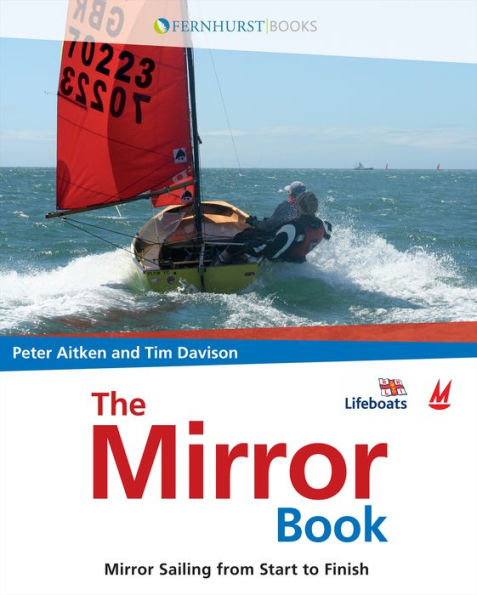Read an Excerpt
1 RIGGING A BASIC BOAT
The standard Mirror dinghy can be rigged in a few minutes – with a little practice! A sensible order for putting it together is given below. The boat should then look like the drawing on page ix.
• Point the boat into the wind.
• Loop the jib halyard strop over the top of the mast so the block hangs forward of the mast.
• Loop the two shrouds over the top of the mast (see photo page 4).
• Loop the forestay over the top of the mast.
• Attach the opposite ends of the shrouds to the aft (back) shroud anchorages.
• Run gaff and jib halyards through their respective blocks at the top of the mast, the gaff from stern to bow and the jib from bow to stern.
• Set the mast upright in the aft mast step.
• Fasten the forestay to the forestay chainplate.
• Loop the kicking strap (vang) over the boom.
• Fasten the mainsheet (the rope controlling the mainsail) on the port side of the transom. Lead the mainsheet through the eye of the boom and back through the eye on the starboard side of the transom. Tie a figure-of-eight knot in the end (see page 7).
• Attach the boom to the gooseneck.
• Slide the mainsail up the gaff and fasten the peak of the sail to the top of the gaff with a short length of rope.
• Insert the sail battens (thin end first) in their batten pockets.
• Fasten the clew of the mainsail to the end of the boom with a shackel. Tie a second piece through the clew and around the boom.
• Wind the luff rope around the mast. Tie a second piece through the tack and around the mast.
• Hoist the gaff tight to the mast.
• Secure the downhaul and luff rope.
• Attach the jib head to the halyard and raise the jib slightly.
• Attach the jib hanks to the forestay.
• Fasten the jib tack to the forestay anchorage with a length of rope.
• Fasten the jibsheets to the jib clew and lead back through the fairleads. Tie a figure-of-eight knot at the end of each jibsheet.
• Hoist the jib fully. Make sure the halyard is tight.
• Attach the rudder and tiller to the transom. Pull the rudder blade up and cleat the rope on the tiller.
• Check the bungs are all in place in the buoyancy compartments.
When afloat, put in the centreboard and push down the rudder blade.
2 RIGGING A GAFF-RIGGED RACING BOAT
Rigging the mast
First, put the strops on the shrouds, forestay and jib halyard over the top of the mast (photo 1). The jib halyard goes on first, followed by the forestay – on some boats these are combined. Then put on the shrouds. Make sure they are all at the correct angle – that is, they should be pointing at the chainplates when the mast is up. The mast may also have a crane for the spinnaker halyard. Spinnakers are covered in Part 2.
• Connect the shrouds to their respective chainplates (photo 2). This is usually via a pin and split-ring arrangement. Later, we will see how to use this to adjust the rake of the mast. For the time being, just make sure that the two shroud lengths are equal.
• Don’t attach the bottom of the forestay at this stage.
• Check that the jib halyard and the main halyard are led through the pulleys correctly, from forward aft for the jib halyard and from aft forward for the main.
• Lay the mast along the boat, and push it aft (photo 3). This keeps the shrouds tight.
• Raise the mast, with its foot down into the front of the cockpit. Then lift the mast onto the mast step (photo 4). (If there are two steps, use the aft one. The forward one is for single-handed sailing, using a mainsail only.)
• Tie the forestay lanyard to the chainplate at the bow (photo 5). The trick is to bend the rope before you try threading it through the top hole of the chainplate. Tension the rope until you can twang the forestay to give a musical note.
• Check that the shrouds and halyards are properly aligned. Secure the halyards so they don’t blow away.
Note that raising the mast is more easily achieved by one person than two.
The boom
• The racing boom will probably come with the outhaul rigged (photo 6). If not, attach it (photos 7 and 8).
• Fit the kicking strap (vang) (photo 9).
• Fit the boom onto the gooseneck with the pin (photo 10).
• Rig the mainsheet (photo 11). There are two eyes on top of the transom. Tie the end of the mainsheet to the port eye, either with a bowline or simply by pushing the rope through from inboard to out, and putting a thumb knot in the end. (This helps the mainsheet fall into the boat rather than in the water.) Now feed the sheet through the pulley on the boom and then through the ratchet block on the other eye. Check that the ratchet block is the right way round – it should be easy to pull in but hold the sheet a bit when it is paid out.
You’re getting there! The next jobs are to attach the sails and then hoist them. The sequence is:
1. Hank on the jib
2. Attach the mainsail
3. Take the boat to the water
4. Hoist the mainsail
5. Hoist the jib.



